Back to Don's Maps
 Back to Archaeological Sites
Back to Archaeological Sites
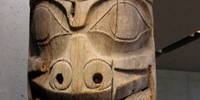 Back to Pacific NW Coast index
Back to Pacific NW Coast index
Canoe designs of the First Nations of the Pacific Northwest
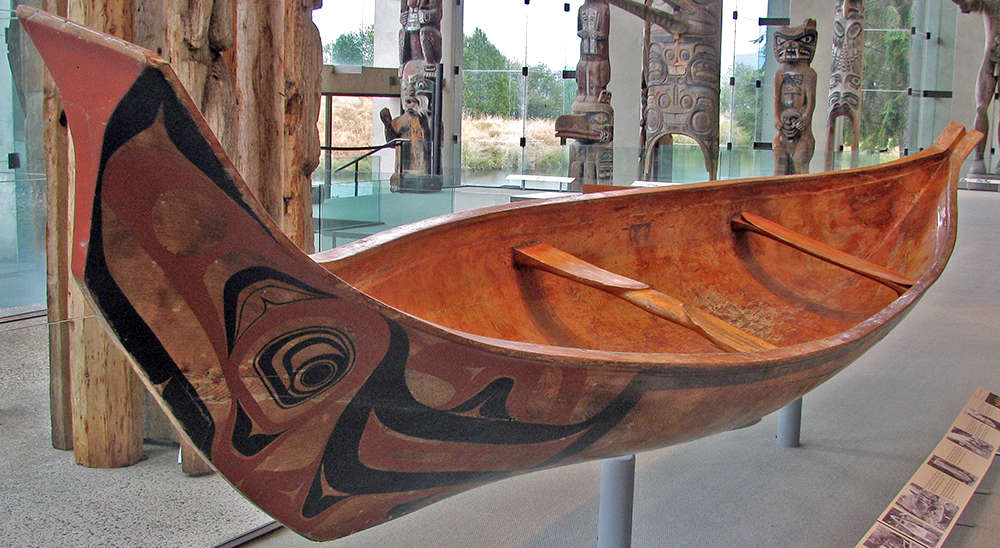
Haida Canoe
Photo: Don Hitchcock 2012
This page contains designs for some of the canoes of the First Nations people of the Northwest Coast. I would be grateful if any reader has other examples they would be willing to share.
The First Nations people of the Northwest Coast are renowned for their elegantly engineered canoes. Ranging in length from three to twenty metres, canoes were essential for travel, transport, hunting, and trade. Different coastal communities developed distinctive styles to suit their particular needs. .
Text above adapted from http://www.civilization.ca/cmc/exhibitions/aborig/haida/havct01e.shtml
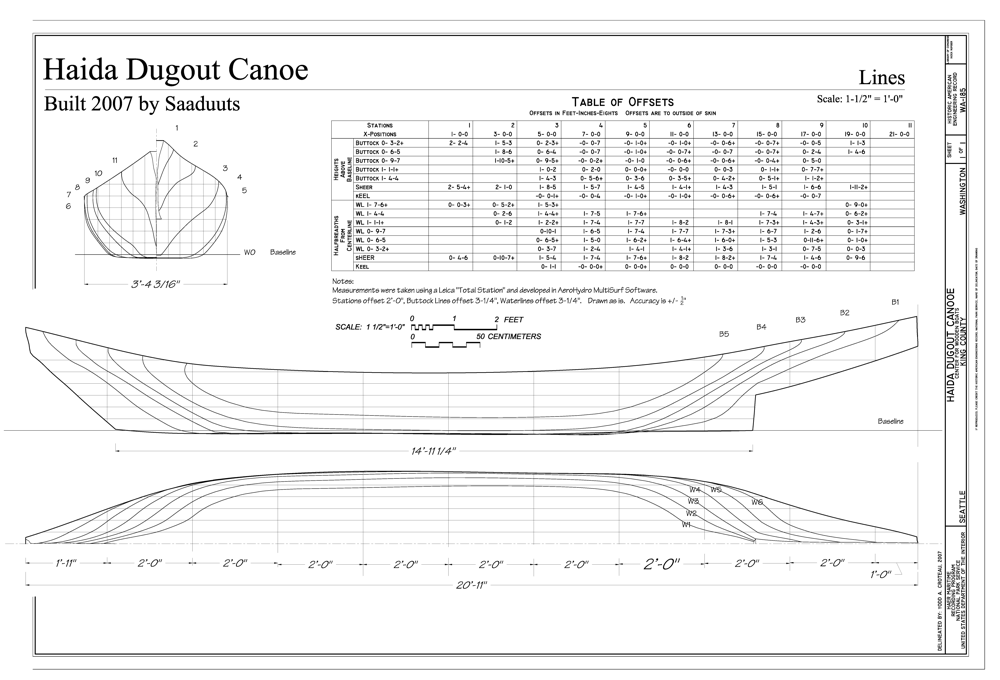
Design for a Haida Dugout Canoe
Photo: Croteau, Todd A.
Here are the records for the canoe design above:
Title: Haida Dugout Canoe, Lines - Haida Dugout Canoe, The Center for Wooden Boats, Seattle, King County, WA
Creator(s): Croteau, Todd A., creator
Date Created/Published: 2007
Medium: 24 x 36 in. (D size)
Reproduction Number: HAER WA-185 (sheet 1 of 1)
Rights Advisory: No known restrictions on images made by the U.S. Government; images copied from other sources may be restricted. (http://www.loc.gov/rr/print/res/114_habs.html)
Call Number: HAER WA-185 (sheet 1 of 1)
Repository: Library of Congress Prints and Photographs Division Washington, D.C. 20540 USA http://hdl.loc.gov/loc.pnp/pp.print
Place: Washington -- King County -- Seattle
Latitude/Longitude: 47.60639, -122.33083
Collections: Historic American Buildings Survey/Historic American Engineering Record/Historic American Landscapes Survey
Bookmark This Record: http://www.loc.gov/pictures/item/wa0844.sheet.00001a/
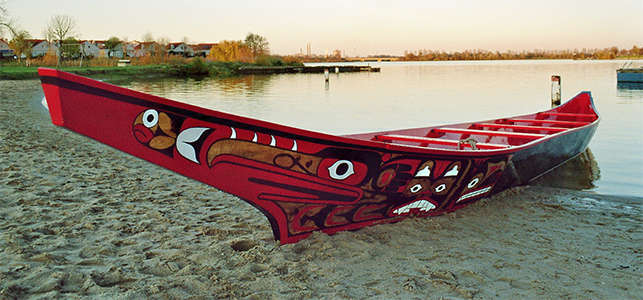
Seagoing dugout canoe made in the Haida tradition.
Photo: Andreas Mensert
Date: 26 November 2006
Permission: GNU Free Documentation License, Version 1.2, Creative Commons Attribution-Share Alike 3.0 Unported license.
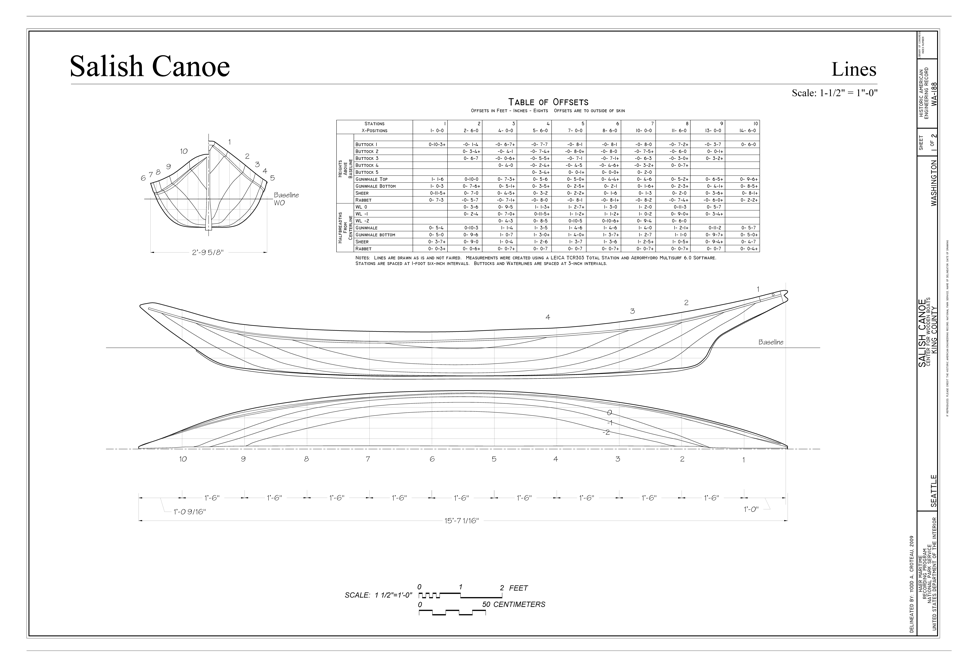
Design for a Salish Canoe
Photo: Croteau, Todd A.
Here are the records for the canoe design above:
Title: Salish Canoe, Lines - Salish Canoe, The Center for Wooden Boats, Seattle, King County, WA
Creator(s): Croteau, Todd A., creator
Date Created/Published: 2009
Medium: 24 x 36 in. (D size)
Reproduction Number: HAER WA-188 (sheet 1 of 2)
Rights Advisory: No known restrictions on images made by the U.S. Government; images copied from other sources may be restricted. (http://www.loc.gov/rr/print/res/114_habs.html)
Call Number: HAER WA-188 (sheet 1 of 2)
Repository: Library of Congress Prints and Photographs Division Washington, D.C. 20540 USA http://hdl.loc.gov/loc.pnp/pp.print
Place: Washington -- King County -- Seattle
Latitude/Longitude: 47.60639, -122.33083
Collections: Historic American Buildings Survey/Historic American Engineering Record/Historic American Landscapes Survey
Bookmark This Record: http://www.loc.gov/pictures/item/wa0865.sheet.00001a/
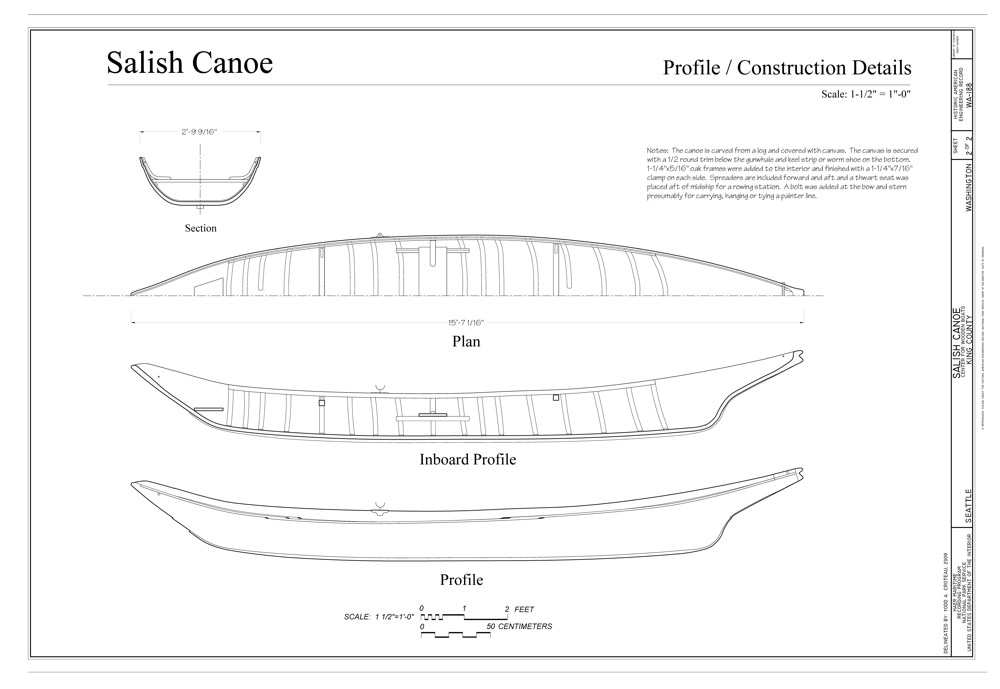
Salish Canoe Profile / Construction Details
Note that this is a dugout canoe, carved from a log and then covered with canvas, perhaps to add durability. The canvas is secured with a 1/2" round trim below the gunwhale and keel strip or worm shoe on the bottom. In addition, oak frames have been added to the interior, and spreaders are included forward and aft, presumably for strengthening.
Photo: Croteau, Todd A.
Here are the records for the canoe design above:
Title: Salish Canoe, Profile/Construction Details - Salish Canoe, The Center for Wooden Boats, Seattle, King County, WA
Creator(s): Croteau, Todd A., creator
Date Created/Published: 2009
Medium: 24 x 36 in. (D size)
Reproduction Number: HAER WA-188 (sheet 2 of 2)
Rights Advisory: No known restrictions on images made by the U.S. Government; images copied from other sources may be restricted. (http://www.loc.gov/rr/print/res/114_habs.html)
Call Number: HAER WA-188 (sheet 2 of 2)
Repository: Library of Congress Prints and Photographs Division Washington, D.C. 20540 USA http://hdl.loc.gov/loc.pnp/pp.print
Place: Washington -- King County -- Seattle
Latitude/Longitude: 47.60639, -122.33083
Collections: Historic American Buildings Survey/Historic American Engineering Record/Historic American Landscapes Survey
Bookmark This Record: http://www.loc.gov/pictures/item/wa0865.sheet.00002a/

Design for a Coast Salish Style Canoe
Photo: http://www.paddlinglight.com/articles/free-plans-coast-salish-style-canoe/

Washington Dugout Canoe, 1890.
(note that this design is identical to the Nootka canoes, with the same 'wolf head' prow and vertical stern. The Makah of Washington are closely related to the Nuu-chah-nulth - Don )
Photo: J.W. Collins
Permission: Public Domain
Source: Fishing Vessels and Boats of the Pacific Coast, Government Printing Office, 1892, Freshwater and Marine Image Bank

Coast Salish-Style Canoe
Photo: Jennings (2005)
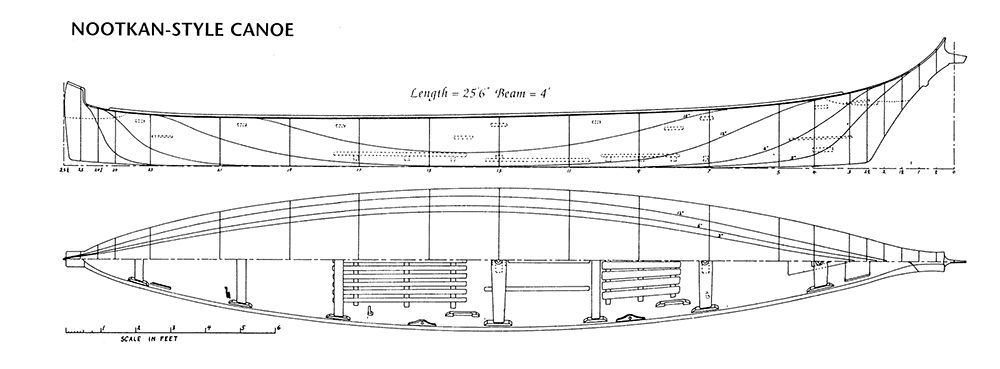
Nootkan-Style Canoe
Photo: Jennings (2005)

Coast Salish Shovelnose Canoe
Photo: Jennings (2005)

Salish Racing Canoe
Photo: Jennings (2005)

Northern-Style Canoe
Photo: Jennings (2005)
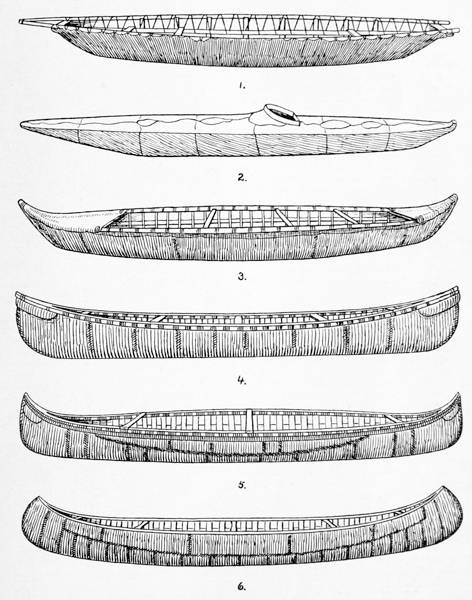
Canadian Canoes
1 Alaskan Eskimo umiak, or open boat
2 Labrador Eskimo kayak
3 Dog-rib canoe
4 Malecite canoe
5 Algonquin canoe
6 Montagnais canoe.
Photo and text: Waugh (1919)
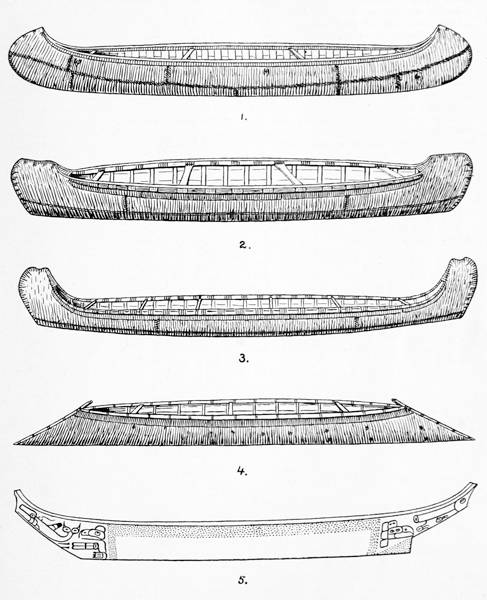
Canadian Canoes
1 Oijbwa canoe (Northern Ontario)
2 Chipewyan
3 Slave
4 Kootenay, Shuswap and other southern BC tribes
5 Haida
Photo and text: Waugh (1919)
My thanks to David Smith for access to this resource.
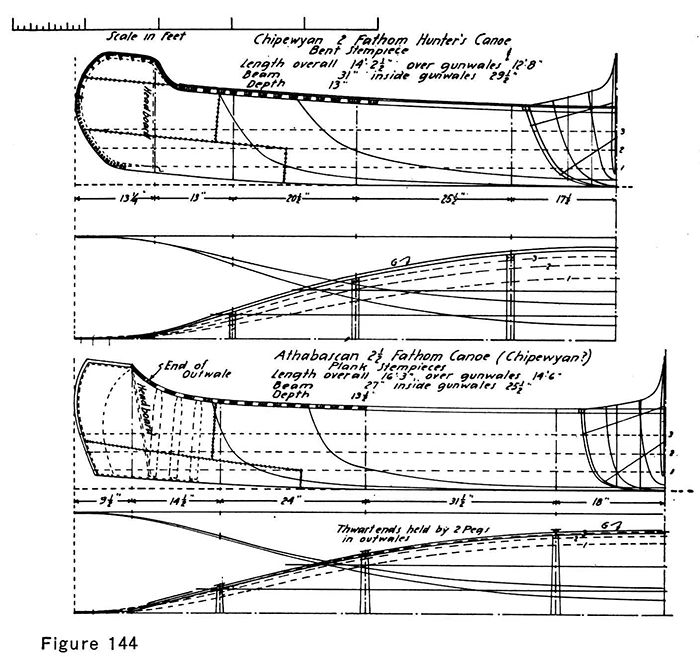
Chipewyan 2-Fathom hunter's canoe (top), with bent stem piece, and Athabascan 2½ fathom canoe (bottom) with plank stem piece.
Plank and bent stem pieces were both employed in Athabascan canoes. Spruce or birch bark were used without alteration of the design or basic construction methods.
Photo and text: Adney and Chapelle (1964)
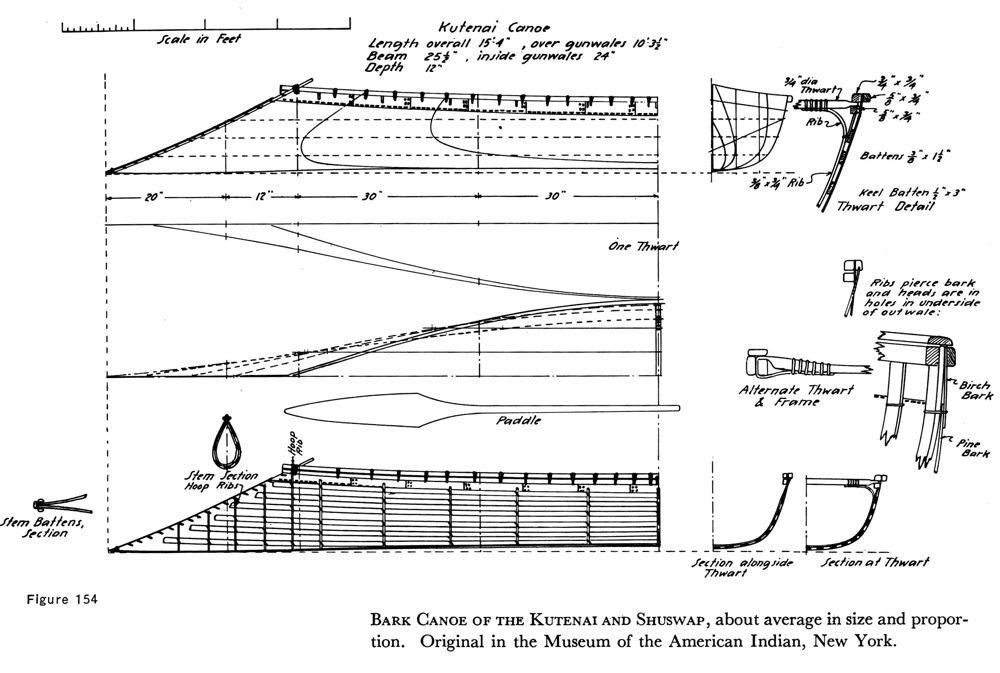
Bark Canoe of the Kutenai and Shuswap, about average in size and proportion, of the Sturgeon Nose type.
Original in the Museum of the American Indian, New York.
Photo and text: Adney and Chapelle (1964)
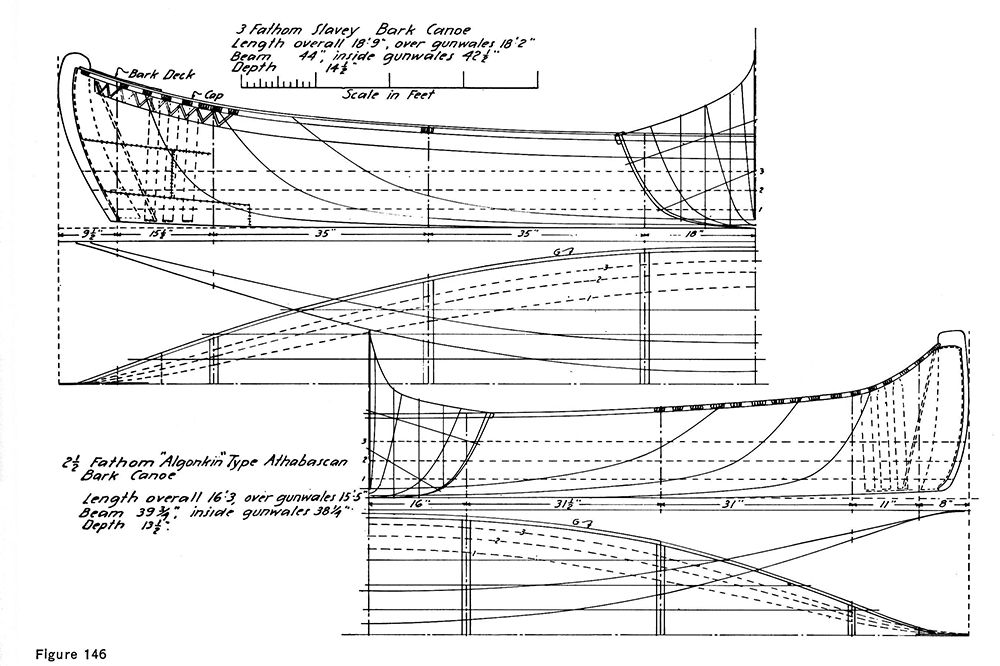
Plank-Stem Canoes of Hybrid Forms, 3-Fathom Slavey (top) and 2½ fathom Algonkin-type Athabascan, probably the results of the influence of fur-trade canoe-building.
Photo and text: Adney and Chapelle (1964)
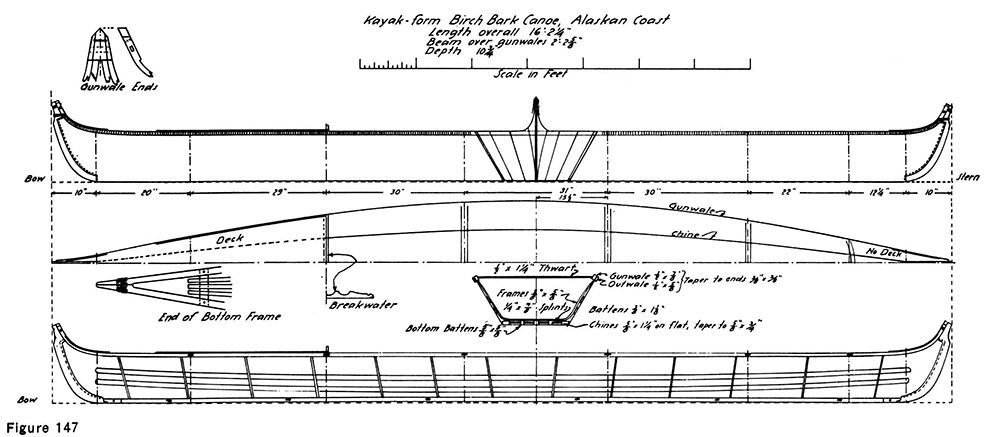
Eskimo kayak-form birch-bark canoe from Alaskan coast, with long foredeck batten-sewn to the gunwales, no afterdeck, and rigid bottom frame.
Photo and text: Adney and Chapelle (1964)

Athabascan hunting canoes of the kayak form, showing characteristic hull shape. These canoes were light, handy, and fast.
Photo and text: Adney and Chapelle (1964)
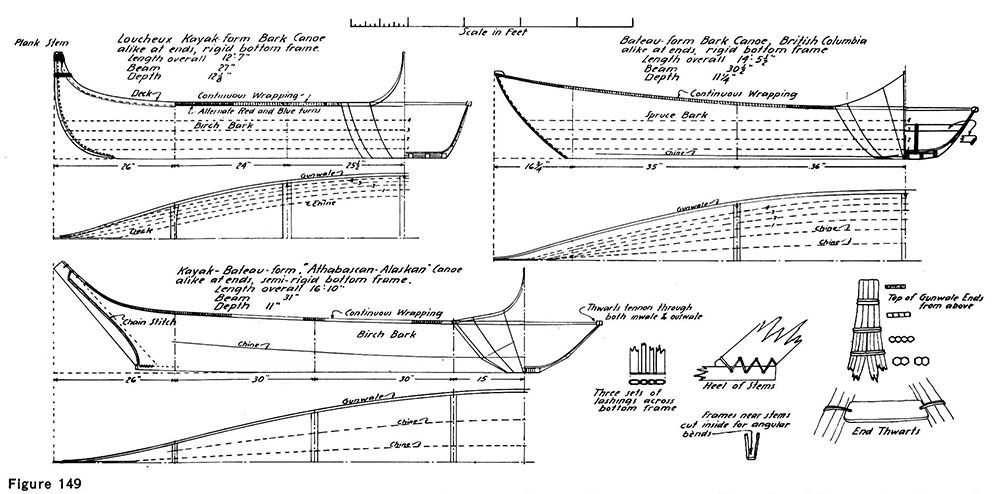
Extinct forms of canoes reconstructed from old models, showing variations in the bottom frame construction and the effects of hull form. Dimensions are estimated from the sizes of canoes in the area of each example.
Photo and text: Adney and Chapelle (1964)
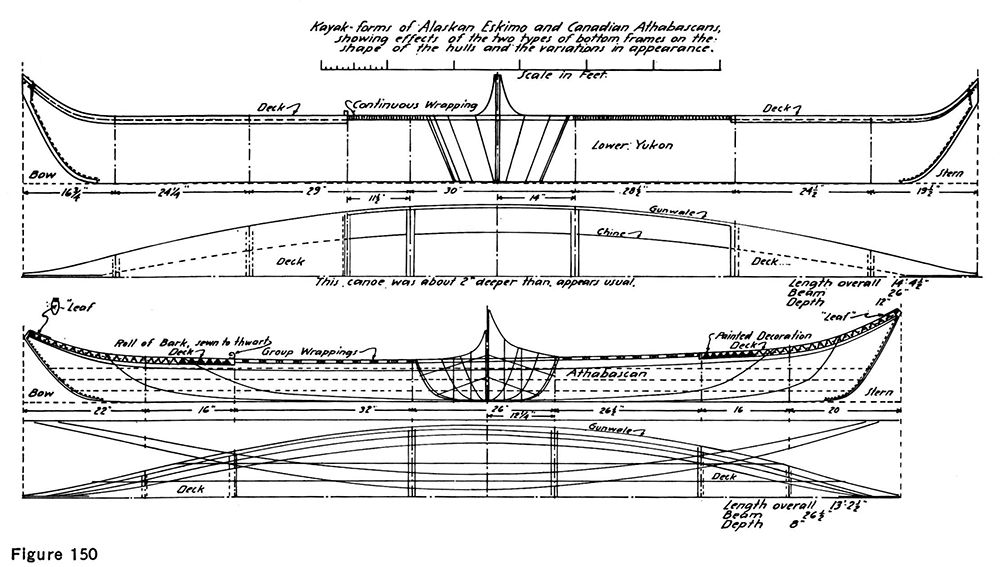
Kayak-form canoes of the Alaskan Eskimos and Canadian Athabascan Indians: chine form of Eskimo birch-bark canoe (above) and the dish-sectioned form of the Canadian Athabascans.
Photo and text: Adney and Chapelle (1964)
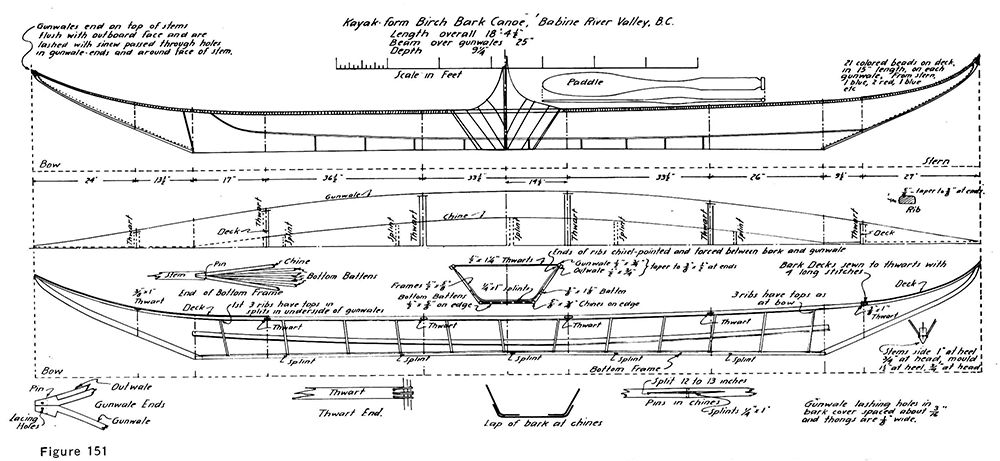
Kayak-form canoe of British Columbia and upper Yukon valley. Shows hogged bottom, usual in the type with a rigid bottom frame, which becomes straight or cambered when canoe is afloat and manned.
Original in the Museum of the American Indian, New York.
Photo and text: Adney and Chapelle (1964)
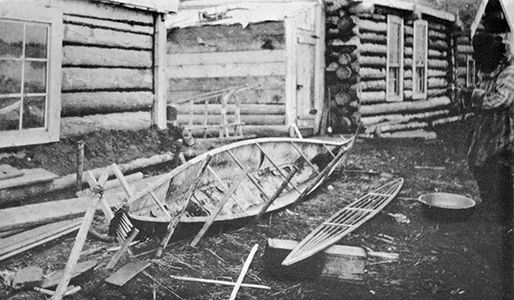
Construction of Kayak-Form Canoe of the lower Yukon, showing rigid bottom frame. (Smithsonian Institution photo).
The kayak-form canoes of the lower Yukon and neighbouring streams all appear to have been small canoes tailored to their owner's weight and height: 14 to 15 feet in overall length, 2 to 2¼ feet wide, and 10 to 12 inches deep. The bottom frame was from 12 to 14 inches wide amidships.
Photo and text: Adney and Chapelle (1964)

Model of an extinct form of birch-bark canoe, Athabascan type, of British Columbia. In Peabody Museum, Harvard University, Cambridge, Mass.; entered in the museum catalog as of 1849.
Photo and text: Adney and Chapelle (1964)
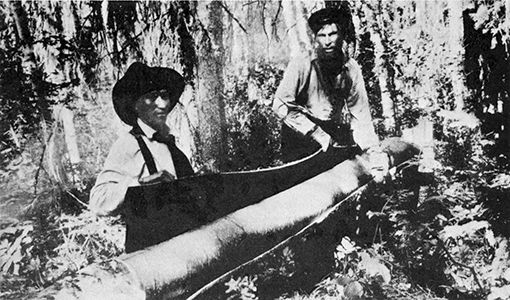
Peeling bark.
Photo and text: Adney and Chapelle (1964)
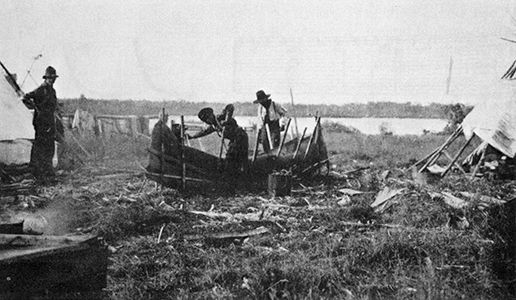
Staking out bark.
Photo and text: Adney and Chapelle (1964)
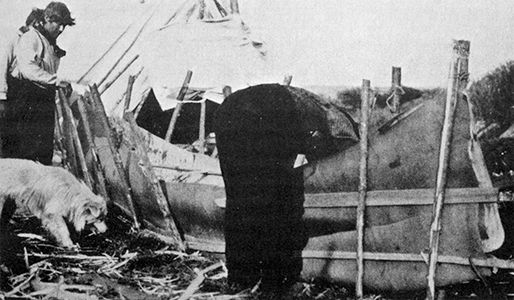
Assembling bark at the building site.
Photo and text: Adney and Chapelle (1964)
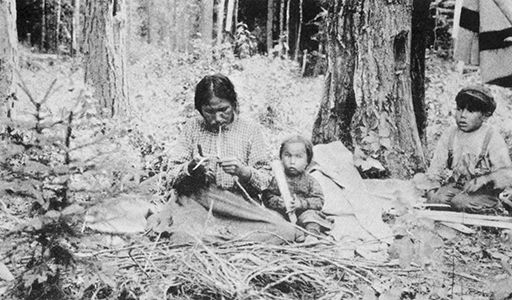
Making root thongs.
Photo and text: Adney and Chapelle (1964)
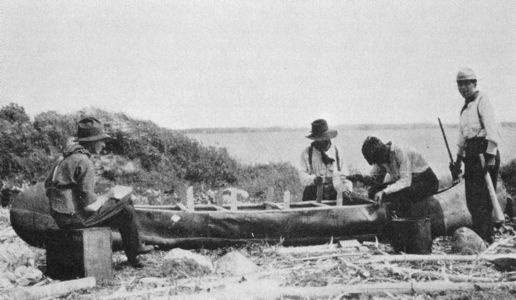
Setting ribs inside bark cover with a mallet.
Photo and text: Adney and Chapelle (1964)
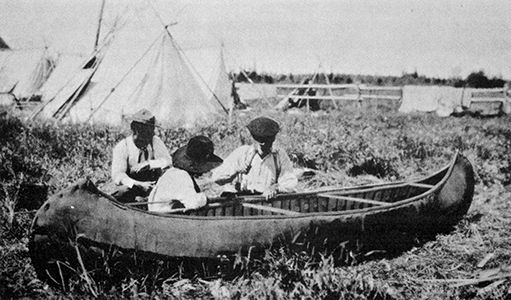
Fitting gunwhale caps on a new canoe.
Photo and text: Adney and Chapelle (1964)
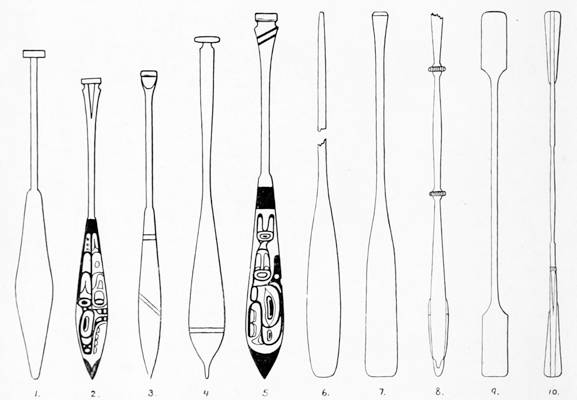
Some typical Canadian Paddles
1 and 4 West Coast paddles, exact locality unknown
2 and 3 Tlingit (northern BC)
5 probably Haida (Queen Charlotte Islands)
6 Kootenay (southern BC)
7 Ojibwa
9 Copper Eskimo
8 and 10 Central Eskimo. (The last three are neighbouring groups)
Photo and text: Waugh (1919)
References
- Adney, E., Chapelle, H., 1964: The Bark Canoes and Skin Boats of North America, Smithsonian Institution, Washington D.C. 1964.
- Jennings, J., 2005: The Canoe: A Living Tradition, Firefly Books, October 3, 2005
- Waugh, F., 1919: Canadian Aboriginal CanoesThe Canadian Field-Naturalist, Vol. XXXIII May, 1919 No. 2
Back to Don's Maps
 Back to Archaeological Sites
Back to Archaeological Sites
 Back to Pacific NW Coast index
Back to Pacific NW Coast index